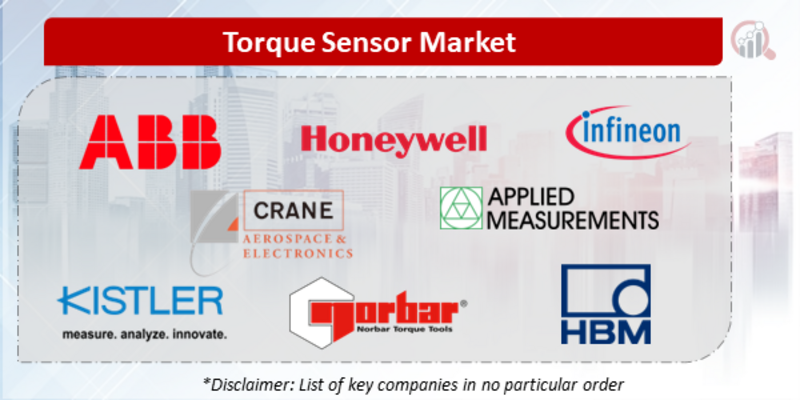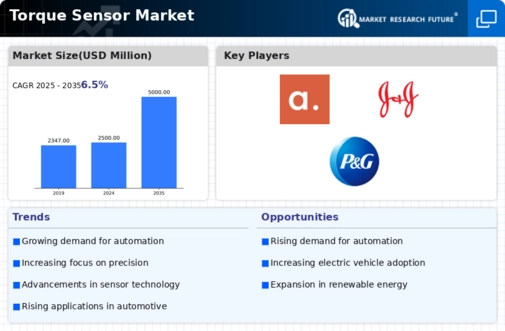Top Industry Leaders in the Torque Sensor Market

Competitive Landscape of the Torque Sensor Market:
The global torque sensor market robust growth is driven by a confluence of factors, including the automation boom, burgeoning demand for electric vehicles, and increasing integration of sensor technology in robotics and industrial machinery. As the market expands, the competitive landscape becomes increasingly dynamic, with established players jostling for position against nimble newcomers.
Key Players:
- ABB
- Honeywell International
- Infineon Technologies
- Crane Electronics
- Applied Measurements
- Kistler Holding
- Norbar Torque Tools
- Sensor Technology
- Hottinger Baldwin Messtechnik
- FUTEK Advanced Sensor Technology
Strategies adopted by companies:
- Product Diversification: Expanding portfolios to cater to different torque ranges, measurement types, and industries.
- Technological Innovation: Investing in R&D to develop next-generation sensors with higher accuracy, faster response times, and improved miniaturization.
- Strategic Partnerships: Collaborating with universities, research institutes, and other sensor manufacturers to share expertise and accelerate innovation.
- Vertical Integration: Gaining control over critical components of the supply chain to ensure quality and optimize costs.
- Cost-Effective Manufacturing: Establishing production facilities in strategic locations to reduce costs and cater to regional demands.
Factors for Market Share Analysis:
Analyzing market share is crucial for understanding the competitive dynamics. Key factors to consider include:
- Revenue and Unit Shipments: These provide a direct measure of a company's market size and influence.
- Geographic Footprint: Presence in key markets like North America, Europe, and Asia-Pacific offers broader reach and customer base.
- Product Portfolio Breadth and Depth: Companies with a wider range of products cater to a larger variety of applications and user needs.
- Technical Performance and Specifications: Sensor accuracy, measurement range, response time, and durability are crucial considerations.
- Brand Reputation and Customer Service: Customer trust and reliability play a significant role in brand loyalty and market share.
New and Emerging Companies:
The torque sensor market is witnessing an influx of innovative startups and smaller players bringing fresh perspectives and technologies.
- MEMS-based Torque Sensors: Companies like Sensata Technologies and TE Connectivity are pioneering the use of Micro-Electro-Mechanical Systems (MEMS) to develop smaller, more affordable, and highly accurate sensors.
- Wireless Torque Sensors: Startups like Anhui Suning Wireless Technology Co., Ltd. are paving the way for wireless torque data transmission, simplifying data acquisition and enhancing flexibility in industrial applications.
- IoT and Cloud Integration: Companies like HBK Kraftwerks Sensors GmbH are integrating torque sensors with IoT platforms and cloud analytics solutions, enabling real-time monitoring, predictive maintenance, and remote data analysis.
Industry Developments
ABB:
- September 2023: ABB announced the launch of its new TorqueMaster TMG211 Series of miniature torque sensors, offering high accuracy and durability in compact designs.
- July 2023: ABB partnered with the University of Oulu in Finland to develop a novel torque sensor for wind turbine blades, aimed at improving blade performance and reducing maintenance costs.
- March 2023: ABB received an order from a leading oil and gas company to supply torque sensors for its offshore platform, ensuring safe and reliable operation of critical equipment.
Honeywell International:
- October 2023: Honeywell showcased its latest torque sensor technology at the MOTEK 2023 exhibition, highlighting its solutions for industrial automation and process control applications.
- August 2023: Honeywell announced a collaboration with a major aerospace manufacturer to develop a customized torque sensor for aircraft engine testing, improving data accuracy and test efficiency.
- June 2023: Honeywell expanded its portfolio of rotary encoders with integrated torque sensors, offering enhanced precision and performance for various industrial applications.








